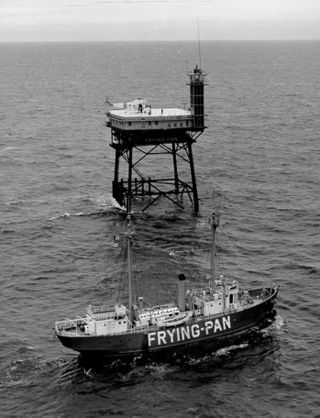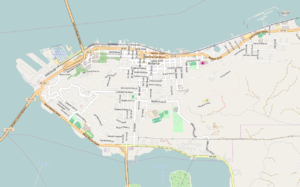
A lightvessel, or lightship, is a ship that acts as a lighthouse. They are used in waters that are too deep or otherwise unsuitable for lighthouse construction. Although some records exist of fire beacons being placed on ships in Roman times, the first modern lightvessel was located off the Nore sandbank at the mouth of the River Thames in London, England, and placed there by its inventor Robert Hamblin in 1734. Lightships have since become largely obsolete; being largely replaced by lighthouses as construction techniques advanced, and by large automated navigation buoys.

The history of the many lightvessel stations of Great Britain goes back over 250 years to the placement of the world's first lightship at the Nore in the early 18th century.

United States lightship Chesapeake (LS-116/WAL-538/WLV-538) is a museum ship owned by the National Park Service and on a 25-year loan to Baltimore City, and is operated by Historic Ships in Baltimore Museum in Baltimore, Maryland. A National Historic Landmark, she is one of a small number of preserved lightships. Since 1820, several lightships have served at the Chesapeake lightship station and have been called Chesapeake. Lightships were initially lettered in the early 1800s, but then numbered as they were often moved from one light station to another. The name painted on the side of lightships was the short name of the Light Station they were assigned to and was the daytime visual aspect of the many Aids to Navigation on board lightships. The United States Coast Guard assigned new hull numbers to all lightships still in service in April 1950. After that date, Light Ship 116 was then known by the new Coast Guard Hull number: WAL-538. In January 1965 the Coast Guard further modified all lightship hull designations from WAL to WLV, so Chesapeake became WLV-538.

Northwest Seaport Maritime Heritage Center is a nonprofit organization in Seattle, Washington dedicated to the preservation and interpretation of Puget Sound and Northwest Coast maritime heritage, expressed through educational programs and experiences available to the public aboard its ships. The organization owns three large historic vessels docked at the Historic Ships' Wharf in Seattle's Lake Union Park; the tugboat Arthur Foss (1889), Lightship 83 Swiftsure (1904), and the halibut fishing schooner Tordenskjold (1911). These vessels are used as platforms for a variety of public programs, ranging from tours and festivals to restoration workshops and vocational training.

The station named Nantucket or Nantucket Shoals was served by a number of lightvessels that marked the hazardous Nantucket Shoals south of Nantucket Island. The vessels, given numbers as their "name," had the station name painted on their hulls when assigned to the station. Several ships have been assigned to the Nantucket Shoals lightship station and have been called Nantucket. It was common for a lightship to be reassigned and then have the new station name painted on the hull. The Nantucket station was a significant US lightship station for transatlantic voyages. Established in 1854, the station marked the limits of the dangerous Nantucket Shoals. She was the last lightship seen by vessels departing the United States, as well as the first beacon seen on approach. The position was 40 miles (64 km) southeast of Nantucket Island, the farthest lightship in North America, and experienced clockwise rotary tidal currents.

The United States lightship Huron (LV-103) is a lightvessel that was launched in 1920. She is now a museum ship moored in Pine Grove Park, Port Huron, St. Clair County, Michigan.

The Columbia River Maritime Museum is a museum of maritime history in the northwest United States, located about ten miles (16 km) southeast of the mouth of the Columbia River in Astoria, Oregon.

Light Vessel Number 83 (LV-83) Swiftsure is a lightship and museum ship owned by Northwest Seaport in Seattle, Washington. Launched in 1904 at Camden, New Jersey and in active service until 1960 after serving on all five of the American west coast's lightship stations, it is the oldest surviving lightship in the United States, the only one still fitted with its original steam engine, and the last lightship with wooden decks. LV-83 was designated a National Historic Landmark in 1989, and has been undergoing major restoration since 2008.

Lightship Ambrose was the name given to multiple lightships that served as the sentinel beacon marking Ambrose Channel, New York Harbor's main shipping channel.

United States Lightship 101, now known as Portsmouth as a museum ship, was first stationed at Cape Charles, Virginia. Today she is at the Portsmouth Naval Shipyard Museum in Portsmouth, Virginia. Portsmouth never had a lightship station; however, when the vessel was dry docked there as a museum, she took on the pseudonym Portsmouth. A National Historic Landmark, she is one of a small number of surviving lightships.

The United States Coast Guard Cutter Fir was the last lighthouse tender built specifically for the United States Lighthouse Service to resupply lighthouses and lightships, and to service buoys. Fir was built by the Moore Drydock Company in Oakland, California in 1939. On 22 March 1939, the U.S. Lighthouse Tender Fir was launched. She was steam driven with twin screws, 175 feet (53 m) in length, had a beam of 32 feet (9.8 m), drew 11 feet 3 inches (3.43 m) of water, and displaced 885 tons. Fir was fitted with a reinforced bow and stern, and an ice-belt at her water-line for icebreaking. She was built with classic lines and her spaces were lavishly appointed with mahogany, teak, and brass. The crew did intricate ropework throughout the ship. The cost to build Fir was approximately US$390,000. Fir's homeport was Seattle, Washington for all but one of her fifty one years of service when she was temporarily assigned to Long Beach, California when USCGC Walnut was decommissioned on 1 July 1982.

United States lightship Nantucket (LV-112) is a National Historic Landmark lightship that served at the Lightship Nantucket position. She was the last serving lightship and at time of its application as a landmark, one of only two capable of moving under their own power. She served as the lightship for such notable vessels as the liners United States, Queen Mary, and Normandie.

Frying Pan (LV-115) is a lightvessel moored at Pier 66a in the Chelsea neighborhood of Manhattan in New York City. It served at Frying Pan Shoals, off Cape Fear in North Carolina, for over 30 years.

United States lightship Relief (WLV-605) is a lightvessel now serving as a museum ship in Oakland, California. Built in 1950, she is one of a small number of surviving lightships, and one of an even smaller number built specifically for the United States Coast Guard. Along with her sister ship, the WLV-604 Columbia, she is a good example of the last generation of lightships built. She was declared a National Historic Landmark in 1989.
USCGC Tupelo WAGL/WLB-303, was a Cactus (A) Class 180-foot buoy tender vessel built by Zenith Dredge Company of Duluth, Minnesota. Her keel was laid 15 August 1942, launched 28 November 1942 and commissioned on 30 August 1943. She was built as a WAGL and redesignated a WLB in 1965.

Lightship Overfalls (LV-118) was the last lightvessel constructed for the United States Lighthouse Service before the Service became part of the United States Coast Guard. She is currently preserved in Lewes, Delaware as a museum ship.

The United States Lightship LV-87/WAL-512 (Ambrose) is a riveted steel lightship built in 1907 and served at the Ambrose Channel lightship station from December 1, 1908, until 1932, and in other posts until her decommissioning in 1966. It is one of a small number of preserved American lightships, and now serves as a museum ship at the South Street Seaport Museum in southern Manhattan, New York City.

The Nantucket Lightship or United States Lightship WLV-612 is a lightvessel commissioned in 1950 that became the last lightship decommissioned in United States Coast Guard service.

The Columbia River Quarantine Station, now known as the Knappton Cove Heritage Center, is a historic site in Knappton, Washington. The station provided fumigation and quarantine services to maritime vessels at the port on the Columbia River from 1899 to 1938, and is the sole remaining quarantine station on the West Coast of the United States as all others were burned for fear of contamination. It was added to the National Register of Historic Places in 1980.






















